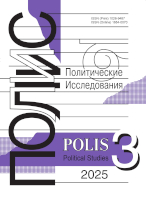Eurasian economic union:
lost in the middle of nowhere
Inozemtzev V.L.,
Dr. Sci. (Econ.), Director of Center for Postindustrial Studies, Head of the Department of World Economy, Faculty of Public Governance, M.V. Lomonosov Moscow State University, slava_in@yahoo.com
DOI: 10.17976/jpps/2014.06.06
Inozemtzev V.L. Eurasian economic union: lost in the middle of nowhere. – Polis. Political Studies. 2014. No. 6. https://doi.org/10.17976/jpps/2014.06.06
In the article analyzing profund changes that occured in the global economy since the second half of the 19th century, Professor Vladislav L. Inozemtsev argues that current economic trends decrease the importance of huge continental landmasses, shift the focus of international trade from land-to the searoutes, and thus signify the emergence of a complex sea-shore economy never seen in previous centuries. He investigates the developments in land and maritime transportation, the patterns of development of both oceanic and landlocked countries and from this point takes on the possible future of the post-Soviet area. Here he points out on a very different paths of landlocked CIS nations and those who possess direct access to the high seas. No one of the latter (Baltic states, Ukraine, Georgia) never expressed any interest in siding with Russia it its efforts to restore the USSR-like political structures in Eurasia, while the landlocked countries (Belarus, Armenia, Kazakhstan, Kyrgizia and Tajikistan) were among the Eurasian Union’s supporters. Therefore, the author concludes, one may say that current Eurasian integration looks like an attempt to impose Russia’s domination on those nations that are highly dependent on Moscow in economic terms. At the same time the author argues that at the era of seaborne economies the expansion into the biggest landlocked territory in the world – i.e. Mackinder’s “Heartland” – will not yield any economic benefits and will only strengthen the commodity nature of Russia’s economy. He also suggest to rethink the importance of the continental (“New Silk Road”, Transsiberian, etc.) transit since it appears to be extremely costly and cannot assist Russia’s economic development. The overall conclusion reads that the eastward direction of Russia’s integration projects is unproductive and will end in restoring economically ineffective and politically outdated Soviet-like structures that may crumble as the new downside trend in commodity prices takes place.
See also:
MacKinder. H.J.,
Democratic ideals and reality. – Polis. Political Studies. 2011. No2
Isayev B.A.,
Geopolitics: classical and modern. – Polis. Political Studies. 2011. No2
Lukin A.V., Lukin P.V.,
Economic policy in post-soviet Russia and the russian history. – Polis. Political Studies. 2011. No4
Korybko A., Morozov V.M.,
Pakistan’s Role In Russia’s Greater Eurasian Partnership. – Polis. Political Studies. 2020. No3
Butler W.E., Entin M.L., Entina E.G., Torkunova E.A.,
Greater Eurasia: In Search of a Legal Order. – Polis. Political Studies. 2020. No4





.jpg)






 print
print
.jpg)
.jpg)